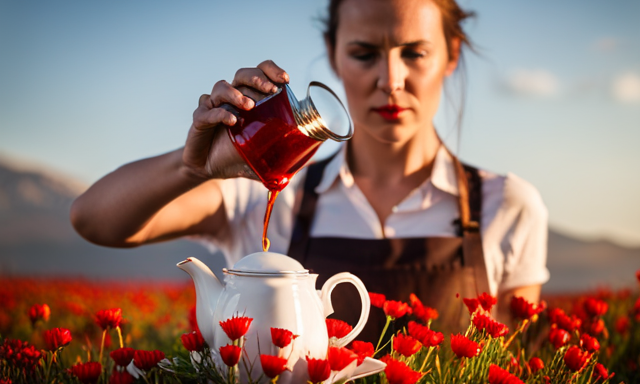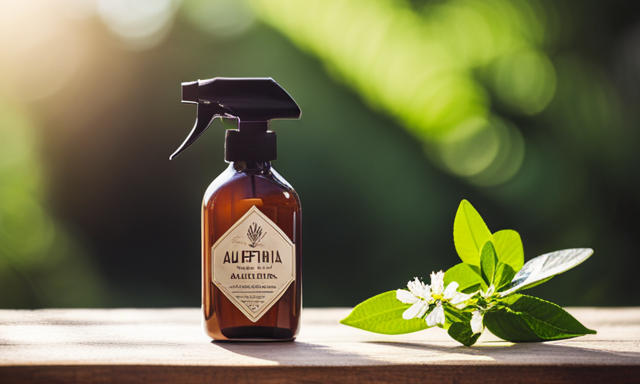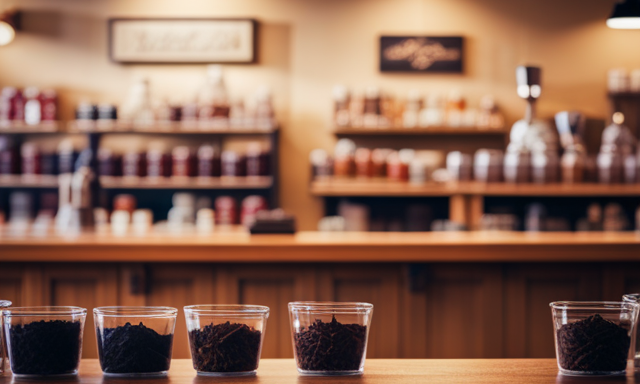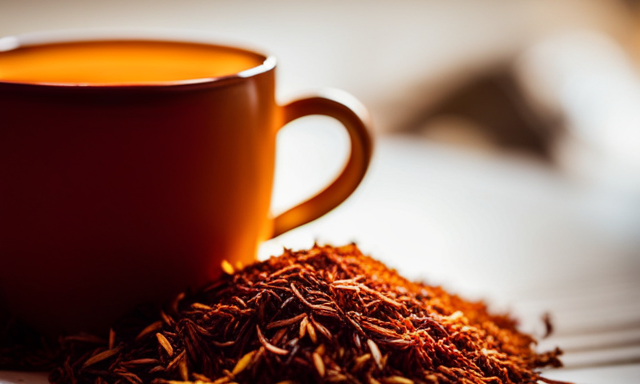As a lover of all things herbal and healthful, I find myself drawn to the intriguing world of the rooibos plant. Its rich, red leaves and unique flavor have captivated me, leading me to explore its many uses and benefits.
What is the rooibos plant used for, you may wonder? Well, prepare to be amazed. Rooibos, also known as ‘red bush,’ is a South African plant that has been cultivated for centuries. It is most commonly enjoyed as a delicious and caffeine-free tea, but its uses extend far beyond the teacup.
With its antioxidant properties and potential health benefits, rooibos has become a popular ingredient in skincare products, natural remedies, and even culinary creations.
Join me on this journey as we delve into the origins, cultivation, and myriad uses of the remarkable rooibos plant.
Key Takeaways
- Rooibos plant is primarily used for the production of a caffeine-free beverage that serves as an alternative to traditional teas.
- The plant is grown exclusively in South Africa, promoting sustainable farming practices and supporting local communities.
- Rooibos adds vibrant flavors and South African charm to cocktails and mocktails, enhancing the complexity of mixed drinks.
- Consuming Rooibos is beneficial for overall well-being, as it is packed with antioxidants, minerals, and vitamins, while also reducing caffeine intake.
The Origins and Cultivation of Rooibos
The rooibos plant’s journey from its humble origins to widespread cultivation is a testament to its enduring popularity and the dedication of those who’ve nurtured its growth.
Rooibos, also known as Aspalathus linearis, is a shrub native to the Cederberg region of South Africa. It thrives in the hot and dry conditions of this area, where it’s been harvested for centuries by the indigenous Khoisan people.
Traditionally, the leaves and stems of the rooibos plant were collected and left to dry in the sun before being fermented, which gives the tea its distinct reddish-brown color and unique flavor.
Nowadays, rooibos is cultivated on large-scale plantations using modern farming techniques to meet the growing demand for its health benefits, which we’ll explore in the next section.
The Health Benefits of Rooibos Tea
Enjoy the health benefits of Rooibos tea, like a soothing blanket wrapping around your senses. Rooibos tea, also known as red bush tea, is packed with antioxidants, including aspalathin and nothofagin, which help fight inflammation and protect against cell damage.
These antioxidants have been linked to a reduced risk of heart disease and certain types of cancer. Rooibos tea is also a great source of minerals like calcium, magnesium, and potassium, which are essential for maintaining strong bones and a healthy cardiovascular system.
Additionally, this tea is caffeine-free, making it a perfect choice for those looking to reduce their caffeine intake. Rooibos tea can be enjoyed hot or cold and can be used as a base in various recipes, such as smoothies, iced teas, and even baked goods.
Transitioning into the next section, let’s explore the different varieties of rooibos tea.
The Different Varieties of Rooibos Tea
Indulge in the diverse array of flavors and aromas that come with the various types of Rooibos tea. Here are three reasons why exploring the different rooibos flavors is a must for any tea lover:
-
Delicate and Floral: Rooibos tea infused with rose petals provides a fragrant and soothing experience, perfect for relaxation.
-
Rich and Spicy: For those who prefer a bolder taste, a blend of rooibos tea with cinnamon and cloves offers a warm and comforting sensation, reminiscent of cozy evenings by the fireplace.
-
Fruity and Refreshing: Try a tropical mix of rooibos tea with pineapple and mango for a burst of summer flavors, a refreshing treat on a hot day.
Discovering the unique characteristics of each variety of rooibos tea can elevate your tea-drinking experience.
Transitioning into the subsequent section, let’s explore the culinary uses of rooibos in cooking and baking, where this versatile plant can add depth and complexity to your favorite dishes.
Culinary Uses of Rooibos in Cooking and Baking
Savor the sumptuousness of Rooibos as you explore its versatile uses in culinary creations, adding depth and dimension to your dishes. Rooibos, with its unique flavor profile and health benefits, isn’t just a popular beverage but also a valuable ingredient in cooking and baking.
Its earthy, slightly sweet taste imparts a delightful twist to a variety of dishes. From soups and stews to sauces and marinades, rooibos can be used in numerous culinary applications. It pairs well with both savory and sweet flavors, making it a versatile ingredient in rooibos recipes.
Incorporating rooibos into your cooking not only enhances the taste but also adds a dose of antioxidants and other health-promoting compounds.
As we delve into the next section about rooibos as a natural remedy for various ailments, we continue to unravel the remarkable properties of this remarkable plant.
Rooibos as a Natural Remedy for Various Ailments
Discover the healing powers of rooibos tea as it soothes and alleviates a range of ailments, providing natural relief and promoting overall wellness.
Rooibos has been used for centuries as a natural remedy for digestive health. Its anti-inflammatory properties help to soothe the digestive system and alleviate symptoms such as indigestion, bloating, and stomach cramps. Additionally, rooibos contains antioxidants that promote healthy gut bacteria and improve digestion.
In addition to its benefits for digestive health, rooibos tea is also known for its stress-relieving properties. The tea contains compounds that help to reduce cortisol levels, the hormone responsible for stress. By calming the nervous system, rooibos tea can help to alleviate anxiety and promote relaxation.
Transitioning into the subsequent section about the role of rooibos in skincare products, rooibos tea’s healing properties extend beyond internal health.
The Role of Rooibos in Skincare Products
With its numerous benefits, it’s no wonder that the skincare industry has embraced the incorporation of rooibos tea. This has contributed to a staggering 40% increase in the production of rooibos-infused skincare products in the past year. The benefits of rooibos in skincare are vast and scientifically supported. Here are four key reasons why rooibos is highly effective in reducing inflammation in the skin:
-
Antioxidant-rich: Rooibos contains powerful antioxidants that neutralize free radicals, protecting the skin from oxidative stress and premature aging.
-
Anti-inflammatory properties: The active compounds in rooibos, such as aspalathin and quercetin, help soothe inflammation, redness, and irritation.
-
Hydrating and moisturizing: Rooibos is a natural humectant, attracting moisture to the skin and keeping it hydrated and supple.
-
Anti-microbial effects: Rooibos has antimicrobial properties that can help combat acne-causing bacteria and promote a clearer complexion.
Transitioning into the next section, let’s explore the art of brewing the perfect cup of rooibos tea.
Brewing the Perfect Cup of Rooibos Tea
Indulging in a steaming cup of this aromatic tea will transport you to a state of pure bliss, as you learn the art of brewing the perfect cup of rooibos tea. Brewing techniques play a crucial role in unlocking the full flavor profiles of rooibos. To ensure a delightful cup, follow these steps:
- Start by boiling fresh water.
- Add one teaspoon of rooibos per cup into a teapot.
- Pour the hot water over the rooibos and let it steep for 5-7 minutes.
- Strain the tea into your favorite cup and savor the rich, earthy flavors.
The brewing process allows the rooibos leaves to release their natural sweetness and delicate aroma. Transitioning into the subsequent section about the sustainability and ethical practices surrounding rooibos production, it is important to understand the careful cultivation and harvesting methods that contribute to the high-quality rooibos enjoyed worldwide.
The Sustainability and Ethical Practices Surrounding Rooibos Production
In my previous subtopic, I discussed the art of brewing the perfect cup of Rooibos tea. Now, let’s delve into a crucial aspect of Rooibos production: sustainability practices and ethical sourcing.
It is imperative to understand the impact of our choices on the environment and local communities. To ensure sustainability, Rooibos farmers implement various practices such as conserving water, protecting biodiversity, and reducing carbon emissions. They also prioritize ethical sourcing, working closely with local communities to promote fair labor practices and provide a better quality of life for workers.
In summary, the sustainability and ethical practices surrounding Rooibos production not only protect the environment but also contribute to the overall well-being of the communities involved.
Now, let’s explore another fascinating aspect of the versatile Rooibos plant: its popularity as an ingredient in cocktails and mocktails.
Rooibos as a Popular Ingredient in Cocktails and Mocktails
Rooibos adds a tantalizing twist to cocktails and mocktails, infusing them with a burst of vibrant flavors and a touch of South African charm. Its unique taste, reminiscent of honey and vanilla with a hint of nuttiness, enhances the complexity of mixed drinks.
Rooibos can be used to create a variety of innovative cocktail recipes, from refreshing spritzers to rich and velvety concoctions. Not only does it provide a delicious flavor, but rooibos also offers numerous health benefits. Packed with antioxidants, minerals, and vitamins, this herbal infusion contributes to overall well-being while tantalizing the taste buds.
Rooibos is a versatile and exciting ingredient that opens up a world of possibilities for mixologists and home bartenders alike. Exploring rooibos blends and infusions for a unique flavor experience, let’s continue our journey into the wonders of this remarkable plant.
Exploring Rooibos Blends and Infusions for a Unique Flavor Experience
After learning about the popularity of Rooibos in cocktails and mocktails, let’s now delve into the world of exploring Rooibos blends and infusions for a unique flavor experience.
As a tea enthusiast, I’ve always been fascinated by the versatility of Rooibos and its ability to be blended with various ingredients to create exciting flavor profiles. Rooibos blends offer a wide range of options to cater to different taste preferences. Whether you enjoy fruity, herbal, or even spicy flavors, there’s a Rooibos blend out there for you.
Additionally, Rooibos is a fantastic caffeine-free alternative to traditional teas, making it an excellent choice for those looking to reduce their caffeine intake.
So, grab your teapot and embark on a journey of discovering the delightful world of Rooibos blends and infusions.
Frequently Asked Questions
Can the rooibos plant be grown in different climates?
Yes, the Rooibos plant can be grown in different climates. Rooibos cultivation requires specific farming techniques such as well-drained soil, full sun exposure, and a Mediterranean-type climate with mild winters and hot summers.
How long does it take for a rooibos plant to reach maturity?
Reaching maturity, a rooibos plant takes around 18 to 24 months. Several factors, like soil quality, temperature, and rainfall, influence its growth. Understanding these variables is crucial for successful cultivation.
Are there any potential side effects of consuming rooibos tea?
There are no known potential side effects of consuming rooibos tea. It is believed to have various potential health benefits, such as improving heart health and supporting the immune system. The recommended daily intake is 2-3 cups.
Can rooibos be used as a natural dye for fabrics?
Using rooibos tea as a natural fabric dye has many benefits. It imparts a warm, earthy color to fabrics, similar to the hues of autumn leaves. Additionally, rooibos tea is non-toxic and hypoallergenic, making it a safe choice for dyeing textiles.
Is rooibos tea safe for pregnant women to consume?
Rooibos tea is considered safe for pregnant women to consume. It is rich in antioxidants, helps with digestion, and may ease pregnancy discomfort. However, it’s always best to consult with a healthcare professional before making any dietary changes.
Conclusion
In conclusion, the rooibos plant is a versatile and fascinating herb that offers a multitude of benefits. It has origins in South Africa and is used in tea, cooking, and natural remedies. Rooibos tea is completely caffeine-free, making it popular for reducing caffeine intake. It has a unique flavor and health properties, making it a beloved ingredient in cocktails and mocktails. Rooibos is produced sustainably and ethically, making it a favorite among tea enthusiasts worldwide.










